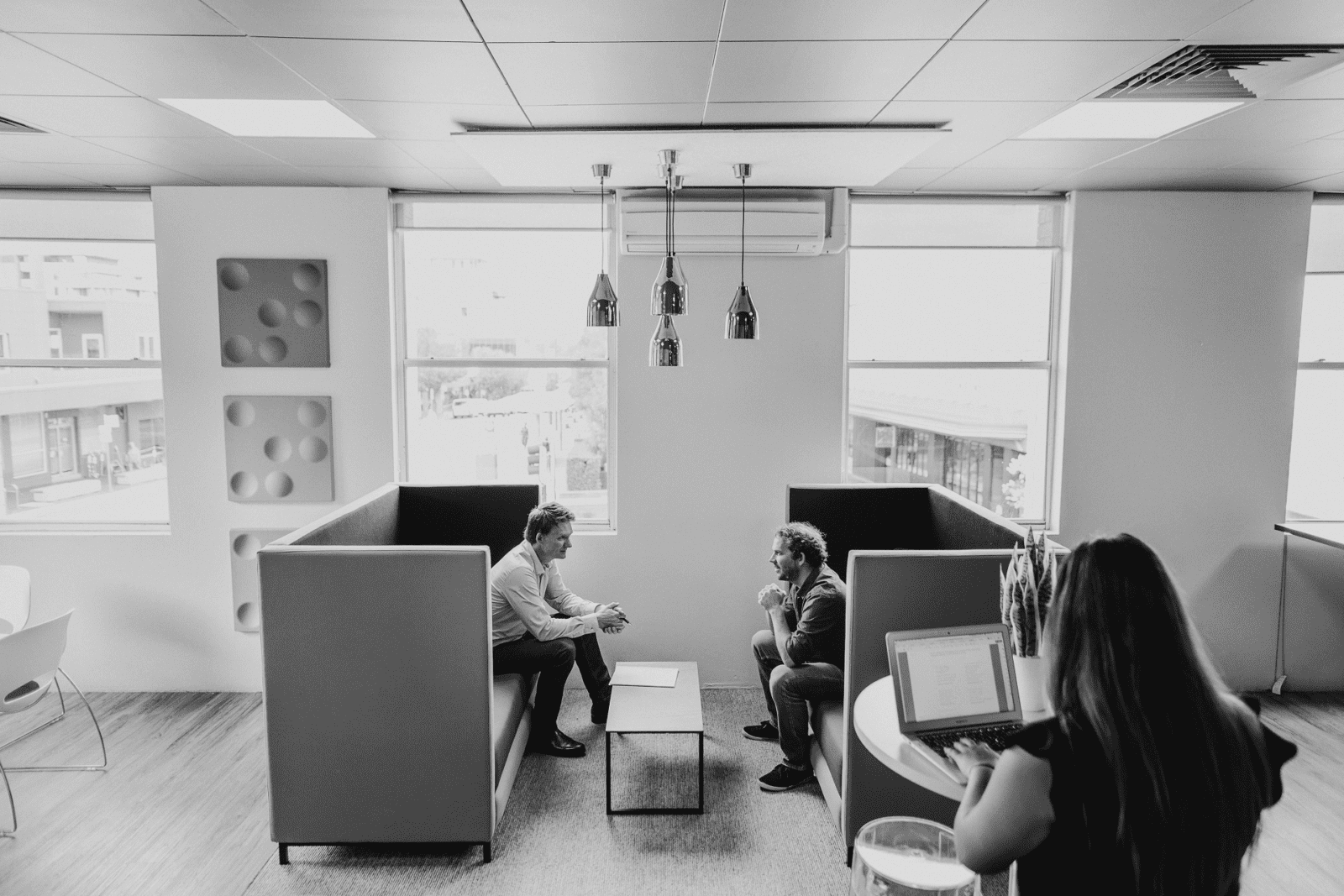|
Author: Xanthe_Addison
Business Matters Newsletter – January 2022
Why I choose coworking at Dashworks
Starting a business – your first 60 days
How to Moonlight Your Way to Self-Employment
Moonlighting: holding a second job, especially at night.
Young medical professionals, in particular, are no strangers to moonlighting. Joshua S. Coren in his article advising young doctors, ‘IS MOONLIGHTING RIGHT FOR YOU?‘ explains the circumstances that led him to moonlighting: ‘When I was a second-year family medicine resident and my wife was a first-year pediatric resident, we struggled with the simplest of financial relationships: income vs. expenses. The income we generated was no match for the expenses of two children, a mortgage payment, day care tuition, basic living costs and student loans. Cutting back on any of these fixed expenses was nearly impossible, so we knew we had to increase our revenue. But how?’
The answer for him, of course, was plying his valuable trade outside of normal employment hours and generating a second income.
Moonlighting, however, is not just for young doctors. Anybody in a tight financial situation will have considered it. Those saving for a house might have, too. The purpose of this article though, is to help people who want to build their own business at the same time as maintaining significant employment. Without further adieu, here’s how to moonlight your way to self-employment.
1) Ask yourself: Why do I want to do this?

Is it that you’re just bored with your 9-to-5? Do you hate answering to somebody else? Are you a risk-taker who’s more excited about giving up sleep and weekends for a few years in exchange for a shot at financial success beyond that of normal employment?
Everybody’s answer will be different. Your circumstances will determine your answer most of the time, and your personality plays a big part too. If you have a morgage and kids, a secure, full-time job combined with flexible hours and 4 weeks’ annual leave probably sounds more valuable to you than moonlighting with no guarantee of a payoff.
A helpful way to analyse whether or not you should begin your business by moonlighting is to think of it in basic investment terms: Risk vs Reward. The risk is, your health may be affected (loss of sleep, extra stress, less time for exercise), your family time may suffer, you might miss out on holidays etc. The potential reward is financial gain, independence, legacy, etc. Knowing which of these things are most important to you will help you accurately assess whether moonlighting your way into self-employment is worth it for you.
2) Identify any conflicts or contractual obligations

This one can stop you dead in the water either from the outset or, catastrophically, once you’ve begun trading.
Step One: Read your employment contract, if you have one. Most employment contracts will have terms surrounding alternate employment, providing paid services in the same industry, etc. You may lose your job or be legally engaged if you breach your contract. Depending on the terms, there may even be a ‘cooling off’ period that prevents you from operating your own business in the same industry for a number of years after termination of your employment. It pays to be vigilant!
Step Two: Identify any potential conflicts of interest. For example, if you’re employed full-time in the Office of Gambling and Liquor, and you want to start a microbrewery, you might need to re-assess one job or the other. Conflicts of interest are taken very seriously by ASIC and other regulatory bodies should an issue present itself.
Step Three: If in doubt, seek legal advice.
3) Get familiar with helpful systems

If this is the first time you’ve moonlighted (or worked for yourself), you’re going to need strong systems to make sure you’re not straying from the path. Some basic systems that may be helpful are:
- Trello – basic project management software. (Free)
- Tracking Time – Chrome extension for tracking your hours. (Free)
- Xero – simple accounting software. ($25/mo)
- Hubspot – simple sales/marketing/CRM platform. (Free)
There’s a million other great platforms and systems that you can use to systematise your workflow and boost your productivity.
Implementing a robust system that encompasses most aspects of your workflow is a great way to make sure you’re not wasting your limited moonlit hours.
4) Optimise your working environment

Make sure you have everything you need in order to be productive from Day 1.
Everyone knows the basics (Computer, desk, phone, stationery), but here are a few things you might not realise you need prior to starting up a business by moonlight:
- A comfortable chair. The dining room chair might suffice, but you’re going to be spending long hours plugging away behind a screen and unbroken concentration is the aim of the game. A rule I live by is: ‘Don’t skimp on anything that connects you to the ground’ – that includes shoes, mattresses, tyres, and office chairs.
- Natural Light. There are many reasons why natural light is so valuable in human physiology and psychology (see this article for more info). In fact, it’s so valuable that you should base your decision on which room in the house to work from based on the amount of available natural light. You’ll sleep better, you’ll be more productive, and you’ll be happier for it.
- A suitable playlist and good headphones to block out distractions. This is obviously very subjective, but these three genres are tried and tested productivity-boosters: natural environments (think: rainforests), video game music (like this), and classical.
- Healthy snacks nearby. I know it, and you know it: you’re not hungry, you’re just procrastinating. If you’re really hungry, that bag of almonds you keep on your desk will do. You don’t need to get up and go to the fridge again.
If you find other tips that work for you, please share in the comments below!
5) Identify what kills your focus, and remove it from the equation

This one is pretty basic.
As you progress with moonlighting, take notice of the things you spend your time on that aren’t work-related. If you find yourself constantly browsing your favourite procrastination destination (e.g. Facebook or Reddit), block it. Google Chrome has a great extension called Block Site that will deter you from visiting and wasting time.
Other time-wasters might be more difficult to remove. Ask your spouse to hide the TV remote or pool cue. Sell the PlayStation. Whatever you have to do. There’ll be plenty of leisure time once you’ve moonlit your way to comfortable self-employment.
6) Watch for burnout

Everybody has a different workload threshold. If you notice these symptoms, take a break. If you’re experiencing these in the short-term, you may not have a long-term in this business.
- Chronic fatigue/lack of energy/tiredness
- Insomnia
- Extreme emotions (e.g. anger, cynicism)
- Anxiety or Depression
- Forgetfulness
- Loss of Appetite
- Detachment/Loss of enjoyment
- Loss of productivity
Taking a break is not a weakness. It’s a sign of self-awareness, and your business will be better for it.
How to Hire The Right Person
At some point in your business (often sooner rather than later), you will need to hire the first person for your new team.

While this is super exciting, it is also something that many people approach with fear and trepidation.
Usually when you start your own business, you don’t plan to have to recruit and manage a team. It can bite you on the butt and take you by surprise ! Here are some super useful tips that you can utilise to make the process easier.
- – From when you start your business, begin to plan what kind of role you want someone to step into.
- – Be uber clear about your own ‘sweet spot’.
- – Hire someone who is all those things you are not!
- – Culture, Culture, Culture. What are the things that are most important to you? Look for them in prospective employees.
- – Remember people come in all shapes and sizes and skillsets, with all sorts of needs: casual, parttime, fulltime, independent contractor. The list is endless, get some advice on this if you need it.
- – At least attempt a Position Description, doesn’t have to be bells and whistles but something that guides the process.
- – Hire slow, fire fast. Take your time to get the right person then you’ll never need to get the second person.
- – Start informal conversations with people you think would fit in your business early.
- – Trust your gut, hire just before you think you need to.
- – Know your people well and work out what motivates them, if ownership is on the table have the conversation early.
- – Make sure you understand your rights and responsibilities as an employer. THISis a great resource for Australian-based employers.
If all else fails, ask for help, there are people that do this stuff for a living and can support you and make the process easy!
Good luck creating the most awesome team imaginable.

How Coworking Improves Your Character
Discounting is dangerous – find out why
Marking down prices can give you an edge over the competition. That boost might not always translate into higher profits in the long run. It seems like discounting can boost revenues, even if it’s only temporary.
There are a few problems with markdowns that are typically overlooked.

Perception is Reality
Customers are vulnerable to price. If a customer is introduced to your product at 30% off, they will associate your product with that price. When the “sale” is over, you’ve more than likely lost that customer. This can be detrimental to businesses that thrive on repeat customers. Additionally, social circles of that customer will also have a “discount” in mind when they view your product.

The Inevitable Price Wars
Marking down a product is a declaration of war on your competition. Of course you should monitor your competitors’ prices, but you can’t compete solely on price. You have to find other ways to build a customer base. If you offer 20%, your competition might offer 30%. What will you do then? Can you afford to continually beat your competitors in the price war? This is another temporary boost to sales but it does impact revenues in the long term.

Cheap Champ
If you continue to promote yourself as the King of Clearance, the transient market will always see you as just that. You’ll be the discount leader, which will help you in a segment of the transient market. Most customers build loyalty. The transient market is only a portion of the market and the cheap champs are an even smaller fragment of that market. Pursuing that group can cost you some of your loyal customers.
Finding the right price point is important. Research shows that customers want to be loyal. What they look for is value. Fair price is essential to value. A low price isn’t always a fair price. You have to consider what you might lose, besides a percentage of profit, before you start marking down your products.
Troy Wink is Director at VBD. Article first published on VBD BLOG.
How to move out of the home office for the first time
In 2016, 33% of Australian workers regularly worked from home (SOURCE), a 50% increase on the 15 years previous. It’s easy to understand why – it’s convenient, comfortable and cost-effective. It ticks so many boxes that many business owners never leave.
However, working from home has inherent problems. This type of workspace doesn’t scale well if you want to employ more people, is rarely an appropriate facility for meeting professional clients, and is not great for networking with other professionals.
If you’re experiencing these problems, you will should consider moving to a commercial workspace. Fair warning though – finding your first professional workspace can be challenging because it either:
- – Takes so long to find, lease, and move into the premise (and time is money)
- – Costs so much to fit-out, or
- – Requires you to commit to a longer term than you’re comfortable with.
The good news is that we’ve developed some key pointers to help make the process of moving into your first professional-grade workspace easier.

1a. Understand your key drivers.
You probably have a good idea of why you feel like moving into a commercial space is a good idea. But deeply understanding your needs now will help you make decisions on a workspace that is not just suitable at present, but also into the future. Some examples of drivers are:
- – You’re planning to employ more people and have insufficient space
- – Your lounge room isn’t appropriate for hosting large clients that you want to work with
- – You’ve got really bad internet at home
- – You’re getting cabin fever at home
- – It’s embarrassing listing your home address on your business cards or website
- – You just want to separate ‘home’ from ‘work’ and reduce distractions
- – It may be helpful to SCORE YOUR DRIVERS IN A DECISION MATRIX to make your decision more objective and numbers-driven.

1b. Understand your non-negotiables.
Diving a little deeper, this step will help you quickly rule out some options that may appear attractive at first glance when you’re ready to start looking around for your perfect space.
List your non-negotiables e.g.:
- – Must have parking for 3 employees
- – Must have disabled access
- – Must have AT LEAST 100mbps NBN download speeds
- – Must have plenty of natural light
– Understanding your non-negotiables before seeking suitable spaces will save you time during the evaluation stage.

2. Research your options.
Here’s a quick overview of three options that are suitable for first-time commercial office seekers, and their major features and benefits of each.
- Coworking Spaces.
- With the rise of flexible working arrangements, remote employment and entrepreneurship, coworking spaces have sprung up in almost every metropolitan and regional city in the western world. Coworking offers:
-
- – Flexible, affordable month-to-month memberships. You don’t need to commit to a 3-year lease when you’re not sure if you’ll still be in business in 12 months’ time.
- – Furniture and outgoings provided. It’s plug-and-play, with 0 downtime.
- – Beautiful and high-value facilities like meeting rooms, breakout spaces and high-speed wifi. No more embarrassing client meetings, or frustrating upload speeds.
– A community of like-minded professionals (each space has it’s own ‘flavour’, e.g. creatives, tech, finance etc). No need to carve out time from your schedule for networking, or professional socialising.
- Serviced Offices.
- Serviced offices are similar to coworking spaces, with a few key differences:
- – A focus on private, cubicled workspaces.
- – Short-term leases.
- – Reception services (phone answering etc.)
- Commercial Leases.
- This is where is gets tricky! Commercial leases offer:
- – Lower cost per-square-metre than coworking spaces and serviced offices, although you will need to outlay a lot more for fit-out, furniture, utilities etc.
- – Longer leases are inflexible
- – The right property can be much more scalable and customisable for businesses with high-growth plans.
3. List suitable workspaces in your area.
Now is the time to jump on Google! Search for things like:
- ‘Coworking space [your location]’
- ‘Workspace [your location]’
- ‘Serviced office [your location]’
- ‘Commercial real estate [your location]’
Other ideas for prospecting suitable workspaces are:
- – Contact Commercial Real Estate agents who specialise in leasing (although beware of being led towards something that doesn’t suit you).
- – Search for relevant hashtags on Facebook, Instagram or Twitter (#coworking, #smallbiz, #startupAUS etc) and get a feel for who is active in your area.
- -Contact your local Business Centre or Council.
- – Ask around at networking events or online business networking groups.
4. Assess your listed options against your criteria from steps 1a and 1b.
This will narrow your options down to a shortlist of viable options.
5. Get on-site and see if which option(s) you like.
Now that you only have a few options, you can visit each site and evaluate:
- How easy is it to find? Will it be easy for my clients to visit?
- Are there good eateries/public transport/entertainment options nearby?
- Do I like the aesthetic of the space? Is there enough natural light?
- Would I be comfortable working here?
Most coworking spaces offer a free trial so you can really ‘try before you buy.’
You should have a pretty good idea of which option scores and feels best to you. If it’s impossible to choose – that’s great! Flip a coin.

6. Move.
If it scores well against your criteria, and you’re confident you’ve considered the potential downsides and mitigated those risks, give it a go – especially if there is no long lease period (i.e. a coworking space with month-to-month memberships).
Remember, leasing a commercial property will involve extra downtime (e.g. connecting the internet, reviewing and signing documents, etc) and may involve third parties like solicitors, real estate agents etc, but most serviced offices and coworking spaces are a ‘plug-and-play’ situation where you can immediately move in and get to work. It’s important to bear this in mind when planning workflow or budgeting.
And that’s it!
Now you’ve found a suitable option (at least, for this point in time), reap the benefits of your new space.
If you’d like to try coworking for yourself, book a tour at Dashworks here.
Important Marketing Trends You Should Know About
Marketing moves quickly these days. The business world cycles through new trends and tactics at breakneck speed, and as a small business owner, it can be hard to keep up. But from digital marketing right through to good old-fashioned networking, there are a number of recent trends you can easily cash in on to boost your business’ growth.

Video
In case you hadn’t already noticed, video content is huge right now – and seems like it will continue to be so into the foreseeable future. CISCO’S VISUAL NETWORKING INDEX predicts that by 2019, video will make up 80% of all consumer Internet traffic. So, if you’re not already utilising video content in your marketing, now’s the time to start!
Facebook, Instagram and of course YouTube are the most popular places for video content. Facebook allows you to post live videos as well as regular ones, and Instagram has recently introduced IGTV, a feature allowing users to create a video channel and share videos that are up to an hour long. Whichever platform you’re using for video content, make sure you’re creating clips that encourage engagement and provide followers with useful and/or entertaining content.

‘Temporary’ content
Here one minute, gone the next – that’s the approach many platforms like Facebook, Instagram and Snapchat are taking these days. Instagram has the popular Stories feature, which allows you to post photos and video that disappear after 24 hours; Facebook also has a Stories function, and though it is less popular than Instagram’s, it’s worth utilising. The whole premise of Snapchat is its ephemerality (all posts have a viewing time limit), and while it’s primarily used by individuals, businesses are also using it for content, advertising and GEOFILTERS.
This kind of temporary content is especially useful for your small business if your target audience falls within a younger age bracket (18–34). If that isn’t your ideal client base, perhaps don’t spend too much time on this approach, but it’s still worth giving it a shot to keep your content fresh, fun and current.

Influencer marketing
Influencer marketing involves an online personality being paid to advertise or promote a product or service to their audience. You’d be forgiven for thinking that this is only a tool for big-name brands and companies, but that’s no longer the case. As the focus gradually shifts from celebrities and Instagram stars to authentic content creators (‘micro-influencers’), small businesses can use this marketing approach too.
Instead of focusing on who has the most followers, small businesses do better working with influencers who are prominent in their niche (think: specialised bloggers), who will be able to promote a product genuinely, and whose audience is more likely to be highly engaged.
‘Pay-to-play’ social networks
Platforms like Facebook used to be fairly simple for small business owners. You’d create a post and it would automatically appear in the newsfeed of all your page’s followers. However, Facebook’s 2018 ALGORITHM CHANGES mean that the platform now prioritises ‘posts from friends and family over public content’ (i.e. content from business pages). This has made it much harder for small businesses to get their posts seen by Facebook’s audiences – unless they pay to ‘boost’ them. Instagram has followed suit somewhat, ditching its chronological feed for a predictive algorithm and sprinkling sponsored posts from advertisers throughout.
This kind of ‘pay-to-play’ mentality on social networks seems to be here to stay, so if you haven’t previously been spending anything on promoting your social media posts, it might be time to review your marketing budget. Sinking a little money into social media advertising will help you overcome some of the limits platforms are placing on organic reach.

Measuring services
There’s no point having a great marketing strategy if you can’t track, analyse and quantify its results. That’s where measuring services like MIXPANEL and GOOGLE ANALYTICS come in. These tools allow you to track traffic to your website and measure how people are interacting and engaging with your online platforms. Combine these with social media tools like FACEBOOK ANALYTICS for business pages, as well as TWITTER ANALYTICS and INSTAGRAM INSIGHTS, and you’ll get a good general overview of how your online channels are performing.
Through insightful analytics and data, you can better understand how your marketing campaigns are performing, who you’re reaching, and how you can better target your ideal customers through a customised marketing approach.

Modern networking channels
Networking is often thought of as a separate activity to marketing – not so. Connecting with other business owners face-to-face, whether they are potential clients or not, can measurably help you grow your business – which, after all, is the main goal of marketing. So how has networking changed in the digital marketing age?
Although traditional networking events like Business Network International definitely still provide value, more and more networking is now happening online. Sites like LinkedIn are often the first port of call for connecting with people, and a lot of networking also happens through more casual channels like social media. Furthermore, through sites like MEETUP (which has a DEDICATED BUSINESS SECTION), you can create and join groups with others in your area of interest and network online, as well as organising traditional in-person get-togethers and events.
Need a professional office space to work on your marketing strategy and grow your business? Book your workspace tour and join a community of growth-hungry business owners.






















